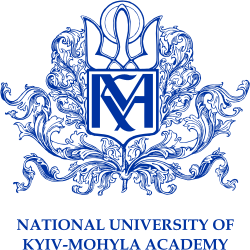Національний університет «Києво-Могилянська академія» | |
 | |
Former names | Kiev Brotherhood School (1615–1632) Collegium Kijovense Mohileanum (1632–1658) Academia Kiioviensis Mohileana (1658–1819) Kiev Theological Academy (1819–1918) National University of "Kyiv-Mohyla Academy" (from 1991) |
|---|---|
| Motto | Tempus fugit, Academia sempiterna (Latin) |
Motto in English | Time passes but the Academy is eternal |
| Type | National |
| Established |
|
| President | Serhiy Kvit |
Academic staff | 180[2] |
| Students | c. 4000[3] |
| Location | , 50°27′52″N 30°31′11″E / 50.46444°N 30.51972°E |
| Campus | Urban, 20 acres (8.1 ha) |
| Colors | Blue & White |
| Affiliations | EUA |
| Website | Ukma.edu.ua |
| University rankings | |
|---|---|
| Regional – Overall | |
| QS Emerging Europe and Central Asia[4] | 131 (2022) |
National University of Kyiv-Mohyla Academy (abbr. NaUKMA) (Ukrainian: Національний університет «Києво-Могилянська академія» (НаУКМА)), colloquially known as Mohylianka (Ukrainian: Могилянка), is a highly ranked national research university located in a historic section of Kyiv, Ukraine.[5] The university is bilingual in Ukrainian and English[6] and is one of Ukraine's few universities with internationally recognized diplomas.[7] NaUKMA takes part in numerous international university collaborations, such as the European University Association.[8][9][10] With around 4000 students, NaUKMA is one of the smallest universities in Ukraine.
The university takes its name from the institution cited as its main predecessor, the Kyiv-Mohyla Academy established in 1615 and operating until 1819. The NaUKMA is located on that Academy's grounds in the ancient Podil neighborhood. In 1991, the modern university was organized, and teaching began the following year. Alumni of the Kyiv-Mohyla Academy played a formative role in the intellectual and church life of Ukraine and Russia in 17th and 18th centuries.[11][12] Among the most notable alumni were hetman Ivan Mazepa and philosopher Hryhorii Skovoroda. As well, Theophan Prokopovich as a rector of the Kyiv-Mogila Academy elaborated upon and implemented Peter the Great's reform of the Russian Orthodox Church. The university is known as pro-Western and served as headquarters for Orange Revolution activists.[7]
- ^ Cite error: The named reference
LawReestwas invoked but never defined (see the help page). - ^ "Information about NaUKMA from the Ministry of Education and Science" (in Ukrainian). Archived from the original on 28 June 2008. Retrieved 16 November 2007.
- ^ Cite error: The named reference
Studstatswas invoked but never defined (see the help page). - ^ "QS World University Rankings-Emerging Europe & Central Asia". Archived from the original on 16 February 2022. Retrieved 15 January 2023.
- ^ "Information on the higher educational institution or affiliate". Archived from the original on 3 January 2008. Retrieved 25 November 2007.
- ^ "National University Kyiv-Mohyla Academy - INTERNATIONAL OFFICE". dfc.ukma.edu.ua. Retrieved 25 February 2023.
- ^ a b "Kyiv Post. Independence. Community. Trust - Ukraine - Education problems deeper than language". Archived from the original on 3 April 2010. Retrieved 2 April 2010.
- ^ "National University Kyiv-Mohyla Academy - INTERNATIONAL OFFICE". dfc.ukma.edu.ua. Retrieved 25 February 2023.
- ^ "NaUKMA – Partners: Education. Science". Archived from the original on 27 August 2009. Retrieved 17 February 2008.
- ^ "European University Association". Archived from the original on 27 September 2007. Retrieved 29 September 2007.
- ^ A. Kamenskii. The Russian Empire in the Eighteenth Century: Searching for a Place in the World. Published 1997 M.E. Sharpe. ISBN 1-56324-574-4
- ^ Kortschmaryk, Frank B. (1976). The Kievan Academy and Its Role in the Organization of Russia at the Turn of the Seventeenth Century. New York: Shevchenko Scientific Society.